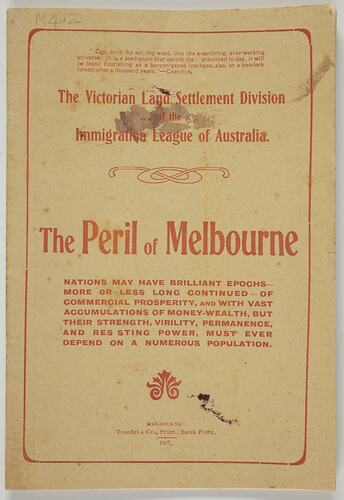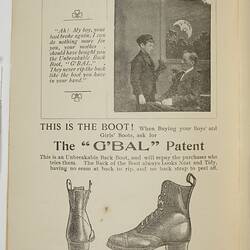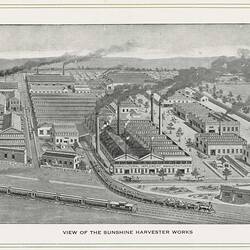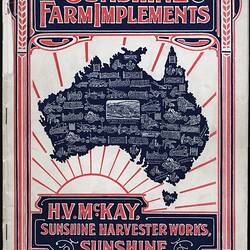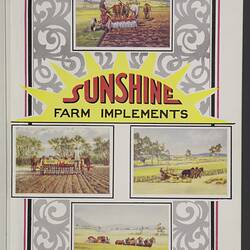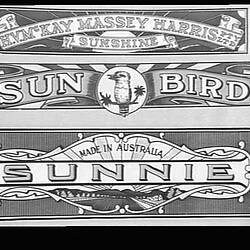Summary
Note: This object includes derogatory references to particular cultural groups. Such depictions are not condoned by Museums Victoria which considers them to be racist. Historical distance and context do not excuse or erase this fact.
Booklet entitled 'The Peril of Melbourne' produced by The Victorian Land Settlement Division of the Immigration League of Australia in 1907. It promotes the increase of primary production and producers in Victoria, land settlement opportunities, and expresses concern regarding the emigration from Victoria of the fit, educated and able. It admonishes the Victorian state government for enabling this situation through thwarting land settlement.
The publication includes the membership, platform and objectives of the Immigration League of Australia, including Prime Minister Alfred Deakin as its president. Its stated platform is 'The settlement and cultivation of our lands, and the attraction of desirable immigrants to Australia' through advocacy of closer settlement, education regarding need to increase agricultural population, dissemination of information regarding land settlement and immigration here and overseas and provision of assistance and advice to arriving immigrants.
The title reference to 'the Peril of Melbourne' refers to the threat to Melbourne's prosperity if rural settlement and production on the land is not increased and assured. The priority for the association is the settling of non-First Peoples, locally-born people on the land and then opening land up for immigrants, The essay also includes negative international comparisons with Victoria regarding primary production, birth and marriage rates. Finally the essay concludes with a warning statement regarding Australia's vulnerability to invasion, particularly by Asian populations.
In the absence of any national immigration selection policy prior to 1920, voluntary agencies formed, including The Immigration League of Australia. It was formed in 1905 by Richard Arthur, MLA for New South Wales with encouragement from Prime Minister Alfred Deakin. A later offshoot was called the Immigration League of Australasia while the original body was renamed the British Immigration League of Australia which focused on immigration from Britain. By 1914 the League had brought 7500 migrants to Australia mostly from London under agreement with the Central (Unemployed) Body for London.
Physical Description
Booklet comprising 40 pages, featuring a yellow paper cover with the title and advertisements printed in red ink. The off-white pages contain advertisements, illustrations and promotional articles printed in black ink. The booklet is secured with two staples along the spine.
Significance
This booklet is an evocative example of the popular promotion of both White Australia and 'populate or perish' sentiments which dominated Australian immigration policy after Federation and which was promoted by organisations such as the Immigration League of Australia and the Australian Natives Association. It is also an example of the voluntary associations which formed across Australia, partly filling a vacuum created by the absence of any coordinated national policy on immigration promotion and selection in Australia until 1920.
Following the 1890s depression, concern arose that too many people were living in Melbourne, especially in the crowded inner suburbs. Large cities were likened to cancers, spreading disease and sapping the nation's strength. The Victorian Government's Closer Settlement Scheme was established in 1904 to entice people away from the inner city. Small holdings for farming were made available throughout the state. In Melbourne, land was subdivided for workers' homes in the fringe suburbs of Footscray, Brunswick, Northcote and Thornbury, and for 'clerks' in the eastern suburbs of Glenhuntly and Tooronga.
In 1915, a royal commission found that the scheme was seriously flawed. Water, sewerage, roads, schools and other infrastructure lagged behind the construction of homes, and the blocks of land were often too small to be viable as farms. By 1916, about 1000 homes had been built. Residents struggled for years, however, to get such basic amenities as roads and water supply. -Melbourne Story text panel, 2008
More Information
-
Collection Names
-
Collecting Areas
Migration & Cultural Diversity, Working Life & Trades, Sustainable Futures
-
Acquisition Information
Donation from Mr. Bernard Smith - Massey Ferguson (Australia) Limited
-
Publisher
-
Printer
Troedel & Co., Melbourne, Greater Melbourne, Victoria, Australia, 1907
-
Person Named
-
Organisation Named
Hugh Lennon, Sunshine, Greater Melbourne, Victoria, Australia, 1907
-
Organisation Named
H.V. McKay, Sunshine Harvester Works, Sunshine, Greater Melbourne, Victoria, Australia, 1907
-
Place & Date Used
-
Inscriptions
Front cover: "The Victorian Land Settlement Division / of the / Immigration League of Australia / The Peril of Melbourne / NATIONS MAY HAVE BRILLIANT EPOCHS - / MORE OR LESS LONG CONTINUED - OF / COMMERCIAL PROSPERITY, AND WITH CAST / ACCUMULATIONS OF MONEY-WEALTH, BUT / THEIR STRENGTH, VIRILITY, PERMANENCE, / AND RESISTING POWER, MUST EVER / DEPEND ON A NUMEROUS POPULATION. / MELBOURNE: / Troedal & Co., Print, Band Place. / 1907"
-
Brand Names
"G'BAL" Patent (Footwear) , Lemming's (Footwear) , Lennon's "Austral" (Stripper Harvesters) , Sunshine (Agricultural Implements)
-
Classification
Agriculture & rural life, Settlement schemes, Promotional materials
-
Category
-
Discipline
-
Type of item
-
Overall Dimensions
18.5 cm (Length), 12.6 cm (Width)
-
Keywords
British Immigration, Closer Settlement Schemes, Immigration, Immigration Policies, White Australia Policy
